Alex oars us through a relatively shallow but wide and burly riffle on the lower reaches of Argentina's famed Collón Curá river, working hard to bring the boat across to a back eddy on the far bank before the current sweeps us farther downstream. It’s a fine looking stretch of water, to say the absolute least. As it turns, from one side of the river to the next, a streambed of terraced shelves is plainly visible to the eye, each shelf creating a spillover beneath the riffle’s surface currents, most of which are sure to be rife with trout. On the near shore, the river’s heavy bend has created a nice cutbank which is also certain to be lined with the Collón Curá’s fat, aggressive browns and rainbows.
We wait for the other boat, which we’ve been traveling with since we put in that morning, to appear around the bend. Once they’ve arrived, we sit down to a luxurious streamside lunch to which we’ve become undeservedly accustomed. Homemade breads, charcuterie and fine cheeses prefix a hearty meal of roasted potatoes and milanesa (a traditional Argentine preparation of thin cuts of red deer, lightly breaded and fried). Despite the fine table and the readily available malbec, we all find it hard to focus much on our meal. A little more than a hundred yards away, the riffle is calling us.
In late summer and autumn, the minnows run in the Collón Curá, transforming its big, resident brown and rainbow trout into aggressive predators that are more reminiscent of saltwater fish than they are of your average trout. These aren’t your typical hole-patrolling, streamer-eating trout which opt to conserve energy until a tasty meal is swung by their noses. These are football-shaped, gorging fish aggressively chasing minnows through the river as if each one was a plump mouse that had tumbled into the water from an overhanging tree branch.

We’d heard tales of the minnow-chasers from Alex and the other guides from Patagonia River Guides, but until now, we hadn’t spied them in their true glory. In the time it took for the lunch table to be set, with the splash and oarslap of our boats removed from the riffle, the trout we had put down on our way through had feverishly resumed their work.
We watch as rainbows porpoise their way through the heavy current, their backs bursting through the surface as they compete for individual minnows despite the bounty rushing through the river to greet them. The riffle frequently explodes with splashes, creating a scene more like one you’d expect to see on an Alaskan river as ocean-fed salmon desperately make their way up waterfalls and through shallows on their way to spawn.
Before long, half-finished lunches are pushed aside and we clamber upstream, finding perches along the riffle. We swing small, sparsely-tied streamers—our best imitations of the tiny minnows flooding the Collón Curá—through the current, drift nymphs of all sizes below big attractor dries, toss easy-to-see mayflies atop the water’s surface. Everything works.
Being greedy, I head for the cutbank at the top of the riffle, figuring to find the biggest of its trout holding there. It's a prime spot, but the current here is more brisk than it appeared from below, and the water tears my fly downstream as soon as it hits the surface. The first fish I hook, a stout, silver-sided rainbow, explodes down and across the riffle and breaks my 3x tippet before I know what’s happened. So do the next three. Knowing there’s more where those came from, I chuckle and tie on another fly.
“You’re going to have to run,” Alex shouts from farther downstream than I’d expect to be able to hear him, confirming my already building suspicion that the only way I’m going land more than a handful of these aggressive trout in water this fast is to speed downriver with the ones that decide to go that way.
It’s literally seconds before I hook the next fish, and with my drag set a bit lighter, I take off on foot as soon as it bolts downstream. The pressure relieved by the foot chase is just enough to keep the fish from popping the tippet and within seconds the fish is likely two hundred feet downstream and clear across the riffle, putting me well into my backing.

As I tromp downstream, I’m unable to stop laughing, making it difficult to warn my companions—who are embroiled in their own encounters with fish below—that I’m hastily headed their way, towed by a line-stealing rainbow.
I’m laughing partly because I’m amazed by the fervor with which a resident trout is putting my normally reserved-for-line-holding reel to work. Steelhead do this. So do salmon. But river trout?
Mostly, however, my sides ache because of the lack of calamitous thoughts running through my head as I stumble downriver. It’s a rare sensation for an angler, but most certainly a fly angler, to play a trout of this quality with such freedom of spirit. Without worries about mistakes, mishaps or bad luck. Without concern of losing the fish. The plenty of the Collón Curá, which we watched hungrily as we meagerly picked at our lunches, has me spoiled, even though I’ve yet to land one of its minnow-chasers.
When the fish finally comes to hand, a shouldered, vigor-filled 22" rainbow, we admire it and let it rest in the net before posing it for the camera and letting it get back to chasing minnows.
Shortly, I'm back atop my perch on the cutbank, waiting to set the whole thing into motion again. And I do, more than a few times. Throughout the expanse of the riffle below, my companions repeatedly play out similar situations. We pause periodically to congregate on the river and share stories or admire the particularly nice fish that make their way to the net, laughing all the while.
We work the riffle for longer than we should, unable to break from the sheer joy of it. As we ply its waters, and pluck trout from virtually every spillover and shelf in its breadth, we are more like boys on a farm pond—with worms dangling on the end of our hooks and the whole of summer ahead of us—than we are grown men that have traveled across the globe to chase trout.





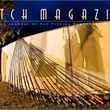

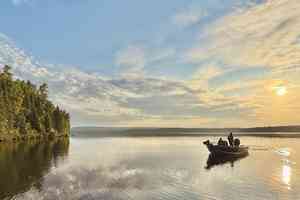




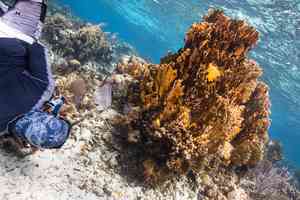

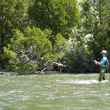
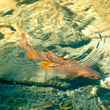




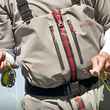



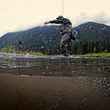
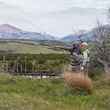
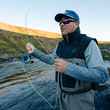
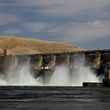
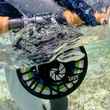
Comments